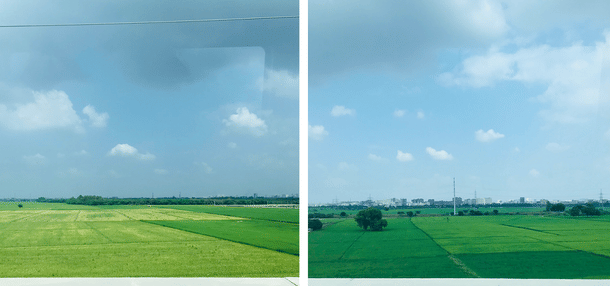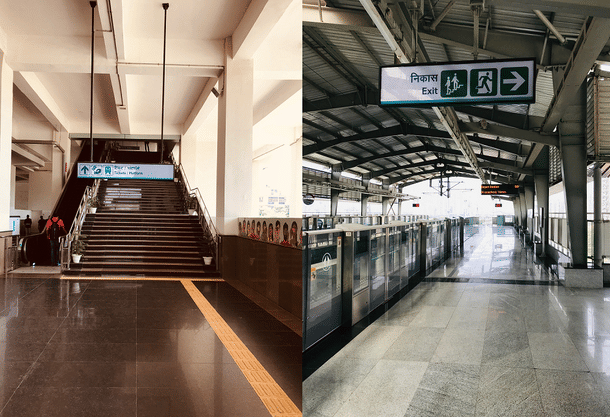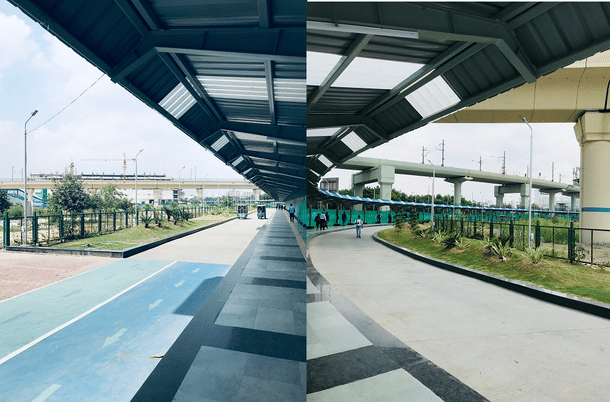Infrastructure
Ground Report: Why Delhi-Noida Metro Must Tackle Operational Challenges Before It Is Too Late
Tushar Gupta
Sep 27, 2019, 11:34 AM | Updated 11:32 AM IST
Save & read from anywhere!
Bookmark stories for easy access on any device or the Swarajya app.
The eleventh network to be operational in India, and fifth-longest after Delhi, Hyderabad, Chennai and Bengaluru, the Noida Metro was inaugurated earlier this year in January after numerous delays.
Known as the Aqua Line, the Noida Metro connects Noida and Greater Noida. Currently, the network has a single operational line (Phase-1) with 21 stations and a total length of 29.7 kilometres while Phase-2 with nine stations is in the planning stages.
The Aqua Line starts at Sector 51 station, which offers a connecting point to the Blue Line of Delhi Metro and ends at the Depot Station in Greater Noida.
The network is under the Noida Metro Rail Corporation (NMRC). This is different from the Delhi and Gurugram metros which come under the Delhi Metro Rail Corporation (DMRC).
While the DMRC operates seven lines (eight if the Aqua Line is counted) across Delhi, Noida, Gurugram, Faridabad, Ghaziabad and Bahadurgarh, it is the Yellow and Blue line where heavy rush is witnessed all day long.
The Yellow Line, with 37 stations, is critical to the Delhi Metro as it connects Gurugram with North Delhi.
Thus, the line hosts crowd travelling to and from Gurugram’s CyberHub, students of the Delhi University, people going to and from the Inter-State Bus Terminal (Kashmere Gate) and New Delhi Railway Station, workers in Central Delhi, and also serves as a link to the crucial Airport Express Line.
Also, the Yellow Line has interchange stations for the Pink, Red, Blue, Violet, and Magenta Line, and the Rapid Metro (operating in Gurugram’s CyberHub).
Similarly, the Blue Line is critical as it connects Delhi to Noida and Ghaziabad. With 58 stations on the network, the Blue Line is essential for professionals working in Noida and Greater Noida, labour force and other workers travelling to Noida and parts of Delhi from Ghaziabad.
Also, the line has interchange stations for the Aqua, Magenta, Pink, Purple, Yellow, and Green Line.
The newly built Aqua Line will have the same significance in the years to come, as the Yellow and Blue Lines have today. Going forward, the Aqua Line will serve as the lifeline metro network for people looking to commute between Delhi, Noida and Greater Noida.
This is because of the following reasons.
Firstly, the region. Noida already hosts offices of leading companies and conglomerates from across the globe.
The last decade has seen a boom in employment prospects in the Noida region, as evident by the increasing number of residential spaces, and the upcoming real and commercial estate projects in the 2020s.
However, the Aqua Line only covers a meagre part of this region, and across the 2020s, the NMRC will have to expand, as the DMRC did in late 2000s and across 2010s.

Secondly, two more networks under the NMRC are under consideration which will directly be linked with the Aqua Line.
One network will further enhance the connectivity between Noida and Greater Noida, while the second one will connect Pari Chowk (one of the stations on Aqua Line with the upcoming international airport in Jewar). The work on these networks is expected to start next year, subject to budgetary approvals.
Three, the upcoming international airport in Jewar.
While the land acquisition for the approved airport is far from completion, there is no doubt that it will be instrumental in moving the traffic away from the Indira Gandhi International Airport in Delhi by the end of the 2020s. With a metro network to the airport in the planning, the Aqua Line will serve as a critical line for passengers commuting to the airport, as the Yellow Line is for commuters looking to take the Airport Express Line.
Lastly, the residential areas around the Aqua Line. Today, the Aqua Line runs across high population density residential areas. These are mainly residential societies with the number of homes anywhere between 200 to 5,000, with occupancy nearing 100 per cent in many of these societies. Thus, there is a steadily growing market for the Aqua Line.
However, Noida Metro’s Aqua Line is far from being a success story it must ideally be, and instead suffers from a number of issues.
Firstly, the ridership. While the line registered the highest ridership for a day on 15 August due to Rakshabandhan, the average ridership number has been in the range of 15,000 per day. The majority rush is at five stations. These are Sector 51 (from where the line begins), Pari Chowk, Knowledge Park, NSEZ and Sector 142.
However, deserted stations are a common sight on the Aqua Line. For instance, the Sector 76 station, which is in the neighbourhood of huge residential spaces, is often empty. Interestingly, the station entrance is a few metres away from Amrapali Silicon City, a residential society that has over 2,200 flats.

In the first month of operations, the lowest per day average ridership was registered by stations in Sector 147 (22), Sector 145 (33), Sector 146 (39), Sector 144 (40), and Sector 148 (128). For the same period, the per day average ridership for Pari Chowk stood at 1,642 and for Knowledge Park at 799, both being hotspots for professionals.
In peak hours, while the Yellow and Blue Lines do not have room for people to stand, the Aqua Line registers numbers that are underwhelming, especially if one takes into account some of the areas it operates in.
While the numbers may lead one to question the viability of the Aqua Line, there is little doubt about it. Given the areas it caters to and regions it covers, Aqua Line, in years to come, will be indispensable to Noida and Greater Noida.
However, the current ridership issues on the Aqua Line can be attributed to the following factors.
One, the connectivity around Sector 51, from where the Aqua Line begins.
What makes Delhi Metro an astounding success is seamless connectivity it offered to the commuters. Even if passengers are required to change two or three stations in their commute, it is never a problem since the changing of lines happens within the station premises. Thus, there is no need for commuters to undergo a redundant security check or to exit the station.
The case for Aqua Line, however, is different, and foolishly so. To shift to the Aqua Line from the Blue Line, one has to exit at the Sector 52 station (on the Blue Line), walk for another 300 metres, undergo another security check, and then board the Aqua Line.
While interchanging stations require commuters to walk, the transition is made easy with escalators, lifts, and sheltered walkways. The transition at Sector 52-Sector 51 stations offers no such option.
Instead, a walkway has been recently inaugurated and is being celebrated for nothing, given it is not equipped to handle the rush Aqua Line holds potential for. It’s not a solution, but a distraction from the real problem.

Two, this difficult transition alienates people from using the Aqua Line. Many routine commuters prefer getting down at the Botanical Garden station, one of the most significant stations within the DMRC network and on the Blue Line, and opt for a shuttle service to Noida or Greater Noida.
Leading shuttle operating companies have services at the Botanical Garden station at far cheaper costs than the Aqua Line metro. For some commuters, opting for a shuttle service instead of the Aqua Line metro also saves time.
Three, the problem of one-metro-two-systems. Unlike the DMRC, where one can travel using a single card, the Aqua Line requires users to buy a separate ticket or hold a separate card issued by the NMRC in collaboration with the State Bank of India (SBI).
Even Rapid Metro, when it was not under the operational control of DMRC, did not have a separate ticketing system. Thus, for a line that is going to be critical to the Delhi-Noida connectivity in future, and only serves 21 stations at this point against 250 being served under the DMRC, the idea of a separate ticketing system is ridiculous.
Yes, a decade down the line when the Aqua Line links to 100 odd stations across Greater Noida and the international airport in Jewar, a separate ticketing system could perhaps be justified, but currently, it comes across as a redundant exercise in futility.
Going forward, for the greater good, the NMRC should be looking to expand the station at Sector 51, and find a way to merge it with the one in Sector 52 (on the Blue Line).
The NMRC could take a cue from stations like HUDA City Centre, Botanical Garden, or even Hauz Khas. The idea should be to make the transition between the Blue and Aqua lines as seamless as possible with intelligent use of the available space between the stations of Sector 52 and Sector 51 (Aqua Line).
Two, the ticketing system must be integrated. The redundant ticketing system is an operational hazard lesson for other upcoming rail networks across India as well.
The Aqua Line is the next big thing for the metro in the National Capital Region (NCR) after the Yellow and Blue lines.
Unlike Gurugram, where today, the Yellow Line only covers a small part of the city, the Aqua Line is ahead of its time in coverage and operations. The NMRC has done exceedingly well with the infrastructure of the network, but it is the connectivity front where they are yet to achieve success.
However, with time on their side, the NMRC, in collaboration with DMRC, the state government of Uttar Pradesh, and Central government amongst other stakeholders, must look to correct the obvious faults in their operational network before it is too late.
Tushar is a senior-sub-editor at Swarajya. He tweets at @Tushar15_





